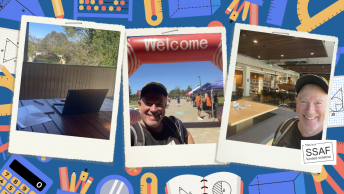This post is over three years old, the information may be outdated.
Well COVID-19 turned one on for us. Trump gorged himself on bleach and malaria tablets, Kleenex puppies were missing in action, and Charles Sturt’s exams moved online.
We don’t know what to tell you about the first two, but let’s cover some ground on that last one.
With COVID-19 social distancing measures still in place, our exams have moved from traditional face-to-face exams, to a range of online exam formats.
The format of your exam depends on your subjects. Your exam arrangements are listed in your exam timetable and on your Interact2 subject sites, and you can find out more about each format on our dedicated exams page.
It sounds a touch overwhelming, but there are plenty of supportive measures in place to help you succeed in your online exams. Here’s a quick rundown of what you need to do to prepare.
- Check out your personal exam timetable and Interact2 subject sites. This will include information about the weighting of your exam, when the exam will take place and what systems you may need.
- Access online study support. The Online Study Team usually supports our online student cohort. As your study has moved online due to COVID-19, that includes you at the moment too! You can either join a workshop for advice on how to prepare for your online exams or book a one-on-one appointment for individual support. They also run a number of helpful workshops in relation to studying online.
- Get a feel for it with a practise exam. The more that you prepare yourself, the more confident you will feel when the time comes to take your online exam. Most students will be able to take a practise exam through your Interact2 subject sites to familiarise yourself with the online exam environment.
- All systems go. In the week of your exam, test any systems you may require before your exam, to avoid any technical issues on the day. You’ll need to check that you have:
- a desktop computer or laptop (tablets, Chromebook and smartphones do not the requirements)
- a working built-in or external webcam and microphone
- internet speed of at least 2 Mbps download and 2 Mbps upload
- a browser with pop-up blockers disabled.
- Set up your exam space. Find a private area that is quiet and free from clutter and unauthorised materials. You should treat this as a regular face-to-face exam.
That means: no phones, no watches, no briefcases, or backpacks. You are allowed to have a small, clear bottle of water, and any prescribed materials specified by your Subject Coordinator in your subject outline, such as calculators, textbooks or reference materials.
You do not need to find a room that is completely empty. You should, however, try and remove things such as books or papers from your immediate vicinity so that you won’t be found guilty of sneaking a look at good old BOB (back of book)! Having these items close by may even be considered academic misconduct if not specified as permitted in your subject outline. - Know where to access technical support. If you experience a technical failure during your exam, there’s no need to worry. There will be technology time allowances given to most time-limited exams to account for any technical issues. You can also refer to our technical support page for more information. Make sure your contact details are up-to-date in your Student Portal so that the we can contact you if necessary.
Transitioning to online study hasn’t been easy, but given the current global climate, online delivery is the best way for Charles Sturt to ensure the safety and wellbeing of our community and minimise disruption to your future studies. This will all be over in the near future, so for the meantime, enjoy wearing your PJ’s and ugg boots to your exams. For the record, it’s socially acceptable!









